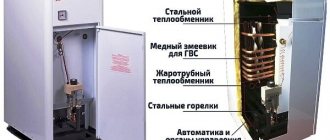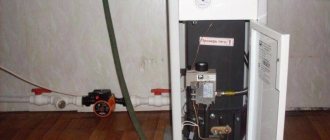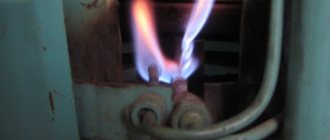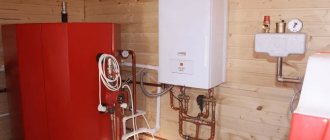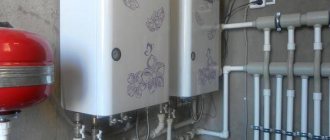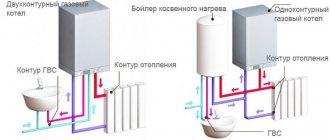- Instructions for preparing for launch
- Features of filling the system with water
- How to remove air pockets?
To ensure the operation of the heating system, various heating equipment is used, but the most popular are double-circuit gas boilers. They are not only economical, but also very reliable, provide excellent heating of the entire house, and are able to uninterruptedly supply hot water to the consumer. In order for the gas boiler to work normally, it is necessary to organize its initial start-up, during which the system is filled with water and all air pockets from the radiators and pump are completely removed. For batteries, Mayevsky taps are used to make it more convenient to remove air from the system. They unscrew until water comes out.
To remove air from the pump, the front panel of the boiler is removed and the required adjustments are made.
The air is removed quickly, after which the equipment itself begins to work.
Instructions for preparing for launch
To use gas, you need to follow simple instructions. The first launch is carried out when the installation of equipment and piping are completed, and the correct installation is checked. All fastenings and location of the boiler must be made in accordance with fire safety rules. A certain distance must be maintained from the boiler to the wall. Which one you need to look at in the instructions for the boiler. For some models of gas boilers, this condition is not necessary. You need to make sure that there are no flammable objects or materials nearby. The boiler should not be placed near windows, as its operation will be disrupted. Great attention must be paid to ensuring that the body is mounted smoothly and there are no distortions.
After this, the equipment is connected to the cold water supply, all plugs are removed from the pipes, and a special filter with a ball valve is installed at the inlet. This helps protect the system from contaminants that could cause breakdowns. Ball valves must be installed on each pipe used for piping.
When solving the problem of how to start a boiler, great attention must be paid to the installation of gas pipes. In this case, it is not recommended to carry out the work yourself; for this purpose, an employee of the relevant service is invited who makes such a connection, sealing, and, if necessary, installs a gas meter.
What else needs to be connected before launch? It is necessary to install a separate power line for the boiler. The equipment is supplied with an electrical cable and plug; during installation, it is necessary to ensure that there is an outlet next to the boiler; it is better to separate it from the others. Next, a connection is made to the chimney pipe, its draft and performance are checked. The pipe itself must go outside; the conditions for its installation depend on what type of chimney is chosen. The last part of the preparation for starting is to disconnect the boiler from the electricity so that it can be filled with cold water. Next, the absence of leaks is checked, the thermostat is turned on to the maximum value so that the mode switch automatically lights up.
Return to contents
Important Operating Instructions
In terms of operation, gas boilers with a closed combustion chamber are considered safer. Their firebox does not communicate with the room air. However, the power of such boilers is significantly inferior to the power of boilers with an open combustion chamber. Therefore, in private households a second type of boiler is often installed.
The choice of future coolant depends on the goals and operating conditions of the system. If the boiler is expected to be turned off frequently, then it makes sense to think about using antifreeze
The operation of such boilers requires compliance with safety precautions. So, to install a powerful floor-standing boiler, it is customary to use a separate room with a certain size. The boiler is mounted at some distance from the walls. Nearby walls should be protected with fire-resistant material to prevent fire.
A ventilation system must be installed in the boiler room. There should also be a source of natural light. The width of the entrance door must be at least 80 centimeters. The chimney is laid in accordance with the instructions for the boiler and from heat-resistant material. The chimney must rise above the roof ridge by at least half a meter.
One safety measure is to install carbon monoxide detectors. The gas detector will promptly detect the leak of a volatile toxin and warn users about it. It can also be configured so that the ventilation is automatically turned on and the gas supply is turned off. Modern automation allows the implementation of a variety of smart systems.
If the temperature, pressure or gas sensor fails, you must immediately turn off the boiler and call a service technician. Using a boiler without these devices is fraught with serious negative consequences.
SNiP requirements state that a gas boiler must be connected to the main line using a copper pipe or a bellows hose. In this case, a faucet must be installed
If signs of a gas leak are detected, you must immediately turn off the gas tap and open the windows to ventilate the room. Do not turn on the light and try to illuminate the room by lighting matches or a lighter.
The gas boiler must be serviced at intervals specified by the manufacturer. Information about the necessary procedures is indicated in the instructions for the device. For example, you need to clean the chimney, remove scale from the heat exchanger, or clear the fumes from the burner. Then the boiler will last a long time, and the risk of serious malfunctions will be significantly reduced.
When using a gas device, do not turn it on at maximum power for a long time. This may result in the release of steam, which is unacceptable.
Sometimes the boiler begins to make unusual noises and vibrations. This may be due to the operation of the fan. We warn you that all actions that require disassembling the boiler casing automatically deprive the owner of the right to warranty repair or replacement.
However, the owner of the unit needs to monitor the operation of mechanisms and systems that protect the boiler from fire. It is necessary to maintain the temperature in the circuits at around 50 degrees, which significantly reduces the likelihood of mineral deposits forming on the internal surfaces of pipes and devices.
Features of filling the system with water
To turn on the heating system, you must first fill it with coolant, i.e. water, which, after heating, will begin to circulate. A feature of modern equipment is that special manual recharge is not needed. During the first launch, you need to carefully check everything so that further work proceeds smoothly and accurately. Not only a pump is built into the boiler body, but a special tap near the pipe for supplying cold water to the system. When cold water is supplied, noise is heard, this is quite normal, there is no need to panic.
During filling, you need to monitor the pressure in the system; special sensors and pressure gauges are provided for this. Modern equipment necessarily has such additional elements, so there is no need to purchase them separately. As the gas boiler fills, the mark on the sensor rises. When it reaches 1.5-2 atmospheres, it is necessary to stop the supply of cold water, i.e., filling is completed. The pressure parameter may be different, since everything depends on the equipment manufacturer and its requirements for the operating pressure in the system. But this is not the final filling; replenishment is necessary as the heating system is freed from air pockets.
Return to contents
Ignition
I configure the combustion regulator according to this principle:
- If the system has coolant shut-off valves, you should use them, or drain the liquid from all the wiring.
- Instead of a specially designed plug, a regulator is screwed in.
- The system is filled and the burner can be ignited.
- Using the handle, you need to find the desired position corresponding to the set temperature.
- I adjust the flame to the maximum, it is advisable to achieve the appearance of a blue segment.
- Using a special valve, it is necessary to remove the yellow part of the fire.
I advise you to rely on the marks on the flywheel, because the exact readings may not be displayed on the regulator; this happens rarely, but you should not forget about this nuance. Regarding the temperature outside the window, it is also necessary to act correctly; in summer this is the area between low and average values, and in winter in the middle of the interval between average and high divisions.
Startup problems
The main excesses responsible for the mandatory adjustment of a gas boiler during start-up include excessive equipment power. Often, when selecting a burner that surpasses a small device in important indicators, problems cannot be avoided. This is due to a lack of air, which leads to the accumulation of soot in the chimney pipe, and the flame will always be yellow.
It is equally important to clean the working ventilation from contamination; if this moment is missed, then problems with draft cannot be avoided. All excess combustion products will not be removed completely, this will lead to a lack of air; by looking at the color of the fire, you can understand what’s going on. If difficulties arise with adjusting the burner flame, you should think about a defect or breakdown of the component itself; gas combustion should increase quite noticeably with a special regulator.
I noticed pressure drops very often, although this factor does not greatly affect the performance, but the chimney will gradually become clogged from fuel emissions, which will lead to incorrect operation of the unit.
How to remove air pockets?
Simply connecting the system by filling it with water is not enough. It will not work or its effectiveness will become extremely low. To carry out a full first start-up of the equipment, it is necessary to bleed all the air that has accumulated in it from the system. A modern gas boiler may have a special system for automatically releasing air when filling, but the efficiency of such systems is low. This means that manual bleeding of the main and other systems is required during connection. Only after this can you start.
Removing air pockets during connection is carried out not only in the circulation pump, boiler, but also in all heating radiators. In this case, it is recommended to start the process with radiators. Especially for this purpose, they are equipped with so-called Mayevsky taps, which you simply need to open by placing a basin under them. At first, a slight whistle will be heard - this is the air gradually leaving the system. If the plugs are removed, water begins to flow. If the batteries are free of air masses, then the taps must be closed. This simplest procedure is carried out with each radiator; it must be checked and cleared of plugs. When air has been removed from all radiators, the pressure gauge needle will be set to the desired value. Before turning on the gas boiler, you need to add coolant to the system, that is, feed it with liquid.
Next, you need to completely remove all air pockets from the circulation pump, which requires disassembling some parts of the boiler. This work is simple, you just need to remove the front panel of the boiler, and then find a cylindrical part that has a lid in the middle of the body, it has a slot for a screwdriver. The boiler must be started, that is, power must be supplied, and the heating regulator must be set to the required operating position. After this, a faint hum will be heard - this will start the circulation pump. You can hear gurgling and other sounds. Using a screwdriver, you need to slightly unscrew the lid of the found part; this should be done until water flows out. As soon as the liquid begins to seep out, the lid must be screwed back on. This procedure needs to be carried out 2-3 times, after which the air pockets will completely leave the system, the sounds and gurgling will disappear, and the pump will begin to operate quietly. Immediately after this, the electrical ignition of the equipment will work, and the gas boiler will begin to operate independently.
The pressure in the heating system must be equalized by adding water to the required level. The system gradually warms up and begins to enter normal operating mode. Connection and first start-up for any heating equipment is a complex and demanding process. How effective the heating will be depends on proper preparation, startup, and adjustment of the system.
The first start-up of the heating system is a crucial moment on which the serviceability of its elements, coherence and uninterrupted operation depend.
How to turn on a gas boiler, fill the radiators with coolant, bleed the air, check everything and not forget anything.
Consider the procedure and rules for putting the heating system into operation.
If the boiler is new and you do not want to lose the possibility of warranty service, you will have to invite service employees. They will make a corresponding note in the passport stating that the first launch was carried out according to all the rules.
Before the boiler is turned on, it must become part of a single heating system.
All its elements, such as:
- pipes;
- radiators;
- pumps;
- filters;
- expansion tank;
- thermostats;
- security group;
Must be installed in accordance with the diagram. Once again, everything should be visually inspected and proceed to filling the system with coolant.
Possible malfunctions when starting the boiler and methods for eliminating them
Failures of gas equipment with electronic controllers can only be repaired by a specialist. If, despite following all the rules, the new gas boiler does not start, the user can independently eliminate the simplest faults.
Cannot turn on igniter
The failure occurs for several reasons:
- the insulator is dirty. To eliminate damage, wipe it with a clean, dry cloth. Heavy stains can be removed with solvents. The element is wiped dry;
- formation of soot deposits in the space between the body and the spark plugs. In this case, no spark appears. You need to tap on the gas supply channel.
If, when the igniter is on, gas does not flow when you turn the knob, there is a risk of problems with the solenoid valve, thermocouple, thermostat or supply valve. These breakdowns are repaired by a specialist.
Advice! If you find a web, you need to unscrew the nut and carefully remove it.
Water does not heat up
The complexity of the breakdown depends on the type of boiler:
- Deposits form on the walls of mechanically controlled contour models. The DHW circuit is washed with hot water and detergents;
- electronic gas boilers do not heat water due to breakdowns of electronics or flow sensors.
Important! Only a professional should troubleshoot electronic equipment.
Clock appears
The failure is typical for devices that heat the coolant at high power.
To prevent the cost of paying for gas fuel and premature wear of the automation, the supply intensity is reduced. You need to adjust it according to the instructions by turning the screw on the valve or using the buttons on the control panel. Correct and consistent activation of the gas boiler will create a comfortable temperature. By following the recommendations of experts, you can easily carry out the first launch of equipment that will be effective in cold and damp weather.
Watch a video on how to properly turn on and start a gas boiler
Rules for filling the system with water before turning on the gas boiler
In the instructions for the boiler you need to find out where exactly it is located (in the lower part of the boiler body) and what the valve for connecting to the water supply looks like. It needs to be opened slightly so that water slowly begins to flow into the system. Smooth filling reduces the amount of air in the radiators.
You can find out that there is enough water in the pipes by reading the pressure gauge. The instructions for a specific boiler model indicate its operating pressure. You need to stop starting the water when the arrow shows pressure close to the highest limit.
For example, if the maximum pressure is 3 Atm., you can stop at 2.5 Atm.
Gas and water supply
Now you need to bleed the air and then pressurize the system.
Work with coolant must be carried out at positive room temperatures, otherwise water may form plugs. If the launch takes place in winter, the rooms are heated with heaters.
Bypass valve
If the batteries in the room warm up unevenly, then it is necessary to increase the speed of the coolant. To do this, the bypass screw is turned clockwise.
If, when the heating is turned on, the liquid in the radiators begins to make noise, this is a signal to reduce the speed of the coolant. This is done by rotating the screw in the opposite direction. To set up and measure, you need to use a pressure gauge or digital differential pressure gauge. It will indicate the nominal pressure, which should not be more than 0.2-0.4 Bar.
Removing air pockets before lighting a gas boiler
Air vents must be installed in the upper fitting of each radiator. These can be Mayevsky taps, or automatic valves.
The automation will handle everything itself, you just need to give it a little time (the fact that the air has escaped will be indicated by a drop in pressure).
To bleed air using a Mayevsky crane, you need to prepare a bucket, a rag, and a special key from the installation kit (or a screwdriver and pliers).
A container is placed on each radiator one by one, the tap is unscrewed, and the air hisses out. Then the battery will begin to “spit” air mixed with water. You can close the air vent when a trickle of water flows from it.
Approximately 5-7 minutes for each radiator - and the first air pockets are removed. The pressure gauge readings are checked (they should drop) and the water tap is turned on again. It would be good to repeat the air release procedure again.
Ultimately, the pressure should be above average, but not maximum, because when the water heats up, the pressure will increase further.
By the way, in order not to splash furniture and walls when air is released, you can hang a cloth on the faucet, along which the water will flow into a bucket.
First start
The first start of the boiler will require filling the system with water, the quality of which must meet all existing requirements.
To start you need to do the following:
- Open the valves of all radiators in the system.
- Slowly fill the system with water to allow air to escape.
- Bleed remaining air from the radiators and boiler.
- Check the pressure on the display and fill in the missing amount (or remove excess).
- Turn off the feed tap and disconnect the system from the supply pipeline.
Before starting, you must once again check the tightness of all connections. If the check shows that everything is in order, the boiler is turned on using the button and the required temperature of the heating system is set.
From this moment the system will begin to work.
Pressure testing and washing
Pressure testing of the system is not the most necessary preparatory stage, but it is desirable, since it will show defects and leaks in advance, if any.
Pressure testing is not always done due to the lack of a special pump and the reluctance to call a team, but if the heating fails in the midst of cold weather, the costs can be much higher!
It is especially important to check a new system and one that, on the contrary, has been in use for several years.
The cost of crimping in construction companies is from 3,000 rubles.
Additionally, they may charge a fee for visiting the site (about 2 thousand rubles). By the way, a manual pressure testing pump will cost 4.5 – 6 thousand rubles.
Turning on the boiler
- The gas boiler is plugged into an outlet.
- The switch must be set to zero.
- The gas supply is turned on (the tap on the gas pipe is opened).
Further actions may differ for different models of gas boilers.
For example, the switch for Aton or Danko boilers needs to be set to the “star” icon, press the entire switch and hold it for 5-10 seconds.
Then, without releasing the switch, press the button located nearby.
The unit will respond with a characteristic click and hum. After which the regulator is released and the required power is set.
To turn on the Baxi boiler, you also need to turn on the gas, plug in the plug and press the “Start” button. The operating sound will appear. You need to give the device a little time, and it will automatically ignite the flame.
After that, you need to press the power button again and connect the heating circuit (the corresponding icon will appear on the display). Finally, using the buttons, the desired temperature is set.
Heating appliances of the Buderus brand are characterized by high reliability. — a brief overview of popular models and their costs.
Let's look at the types of generators for gas boilers.
To organize a full-fledged heating system in a private house, it is necessary to install a boiler. The article discusses the main criteria for choosing heating equipment.
Setting up the ignition device in a cauldron
How to set up the ignition device of a gas boiler?
To set up the ignition device of a Baxi or other gas boiler, you will need a set of tools:
- Pliers.
- Screwdriver.
- Keys.
- Multimeter.
- Alcohol.
Procedure:
- Remove the terminals, short and tighten with pliers.
- Turn on the pilot burner.
- Find out the resistance using a multimeter.
- Not 1-2 Ohms? Get a new meter.
- Norm? Clean the sensor with cotton wool and alcohol.
- Put everything as it was. Check if the ignition device is working.
Circulation pump
The boiler circulation pump requires special attention during startup.
Air often accumulates in it, and its blades sometimes seem to get stuck (the boiler will display a corresponding error).
To do this, you need to remove the front panel of the housing, unscrew the central bolt on the pump and use a straight-bladed screwdriver to turn the shaft in the direction indicated by the arrow.
An air vent is installed above the pump. You need to pull the bright lid up and let the air escape.
Floor-standing boilers are usually more powerful than wall-mounted ones. If you need to heat a large room, it is better to choose this option. — overview of design options and models.
Conclusion
At first, the system may make gurgling sounds, all because during startup it is impossible to bleed air down to the last atom. It will gradually be removed through the expansion tank valve. Periodically check the pressure on the pressure gauge - it should be within the operating range.
Temperature adjustment and other boiler settings are described in the instructions for each model.
Starting the boiler
The boiler must be started when there is a gas supply. The procedure is slightly different for different types of models. Check the instructions for details. Here is the algorithm for how to turn on a wall-mounted gas boiler:
- connect the device to the power supply;
- unscrew the valve on the gas riser;
- press the “Start” or “Start” button;
- set the desired temperature setting on the electronic or mechanical control panel.
Such boilers are equipped with an electronic burner with self-ignition or piezo ignition. In the second case, press and hold the flame control button, and after a few seconds press the ignition button. The initial startup of the boiler or its startup after a long period of inactivity can be blocked by air accumulated inside the gas pipe. This difficulty is eliminated by restarting the unit.
Floor-standing boilers most often do not have electronic automatic ignition. Only piezo is used. To properly turn on the gas boiler, proceed as follows:
- Ventilate the room. There must be normal draft in the boiler chimney or in the ventilation of the room.
- Open the appliance door. Make sure it is set to "Off". on the control handle.
- Turn on the gas supply to the device.
- Rotate the mechanical handle to the ignition position. Press it and at the same time press the piezo button.
- Did you see the burner light up? Hold the handle down for a couple more seconds and then release. If the burner goes out, repeat the procedure.
- Set the desired temperature.
Turning on the gas boiler is half the battle. The heating system must be operated strictly in accordance with safety regulations. Once every 5-7 years, it is advisable to clean the radiator system - rinse it with high pressure of water. Proper use includes periodic testing of the circuit to identify weak points and possible leaks. Both procedures are planned for the warm season as part of preparing the house for winter.
Video on the topic
As a rule, we entrust the first start-up of a gas boiler and the work of setting up and adjusting it to specialists from service centers. Why? Yes, because without their mark in the equipment passport, the manufacturer’s warranty is simply not valid, and in the event of an early breakdown, we will simply be denied warranty repairs.
Whether this is actually the case is, of course, debatable. Specialists from the service center will find a million reasons to refuse you free equipment repair. And even if you get such generosity from them, your repair will last more than one week - either there are no spare parts, or the queue has not yet arrived, or it is wrong. This is a verified fact and it is very difficult to refute it. If you want a quick “warranty repair”, pay both for spare parts and for the work of the technician.
By the way, in order to put the boiler under warranty service, you also need to pay money. So what is this guarantee? Pay for the warranty, then pay for parts and repairs. So where is the free warranty service? That is why, since you already have to pay for everything, I suggest you independently start up the gas boiler for the first time and set up the heating system. Moreover, it is not difficult.
Filling the heating system with water
We look under the bottom of the boiler - where all the pipelines are connected, and look for something like a small valve there. For each model of gas boiler, it can have a different shape: one manufacturer makes it in the form of a valve that is familiar to us, another - in the form of a rotating plastic pin. In general, their form does not change the essence - as a last resort, open the instructions and look at its location.
We open this tap, not completely (so that air does not hang anywhere in the pipes, it is better to fill the system slowly) and direct our gaze to the pressure indicator - the pressure gauge. As a rule, most boilers of this type have an operating pressure from 1 to 3 Atm - read the instructions for more details. We wait until the pressure gauge needle reaches 2.5 Atm and close the valve.
Now the boiler will have to be left alone for a while - air must be removed from each installed battery or convector.
For these purposes, each heating device must be equipped with a Mayevsky tap. We open it and wait for the air to drain and water to run out. The water started flowing and Mayevsky’s tap was turned off. This procedure must be done with each battery. Did you do it?
Now we return to the boiler and look at the pressure gauge again - the pressure in the system should drop. We adjust it, add water if necessary - the optimal pressure at which the boiler operates normally is 1.5-2 Atm. If you pump more, then during operation at a high coolant temperature the excess pressure will be released. This is due to the fact that when a liquid is heated, its pressure increases.
First start of a gas boiler
Having completed all these simple preparations, you can begin to directly start the boiler. Open the gas valve and plug in the boiler. All sorts of symbols and numbers appear on the screen, but for a full launch you still need to perform some actions.
First, press the power button and set the temperature control knobs to the operating position. After these steps, the boiler will begin to make futile attempts to turn on - this is normal and there is no need to be alarmed. The most important thing is that the circulation pump is turned on, inside of which for some reason there is always air that prevents the boiler from fully turning on. It is its removal that needs to be done as quickly as possible.
We remove the front cover of the boiler - in almost all cases it is secured with two or four screws. We fold back the dashboard, behind which the circulation pump is hidden.
In the center of the pump there is a wide screw with a slot for a screwdriver. This is the one you need to unscrew a little, and when water runs out from under it without air bubbles, tighten it again. Only now will full circulation of the liquid in the heating system begin, and the boiler will start working.
At first it will gurgle and make some strange sounds, but this is only for the better. Just know that all these sounds indicate that the remaining air in the system is being forced into the expansion tank, where the automatic air valve releases it to the outside. Five minutes will pass and the system will return to normal - the pressure will stabilize, and the gurgling sounds will subside. And after another five minutes you will already be enjoying warmer radiators and an unlimited amount of hot water in the tap.
That, in principle, is all you need to know in order to start up a gas boiler for the first time. The boiler is working, the batteries are getting warmer, and I think you can figure out how to regulate the temperature of the batteries and hot water in the tap yourself - read the instructions, everything is clearly described there regarding the control of your specific boiler model.
Did you find this article helpful? Subscribe to site updates to receive the latest articles about renovation and interior design before anyone else!
Yes, yes, this is exactly what you thought... A wonderful series of computer (and later not only...) books, Simple and understandable, which was very useful to many.
Your new home has taken good care of you all winter. Saved from bad weather, protected from precipitation, wind, cold... But the sun warmed up, and the winter snowdrifts had long since disappeared. May. It's time to turn off the heating in the house. But as? Here in the boiler room there is so much stuff that can be opened, closed, switched, turned off... It’s almost like an airline pilot :-) What to do? Should we quickly look for the phone numbers of “those guys” who installed the boiler and call them for help? Oh no. This is not our choice. If part of your life is your own home, and if your home is not part of a cottage community, you will have to be an electrician and a plumber and many many others... Well, if you are not a “pro,” then at least be a “teapot”, but one that you can manage yourself with your own home. So let's get back to our problem. Summer is knocking on the door. It's hot outside. It is necessary to turn off the heating in a private house. But as? First of all, we determine what kind of boiler we have in our house. This can be done, for example, by simply looking at the documents that exist for this boiler. If the boiler is double-circuit, then everything will be quite simple - you just need to switch it to the “summer” position. What exactly needs to be pressed and turned for this - read the instructions for your boiler - everything is written there simply and clearly. (For reference. A double-circuit boiler works something like this - the coolant circulates in a circle through the pipes and radiators and “looks” at the temperature of the coolant - if it becomes less than what the owner (or the temperature sensor) set, it ignites the gas and heats it. If the owner of a double-circuit boiler turned on hot water - the boiler “stops” caring about the temperature of the coolant in your heating system and devotes all its efforts to only one task - heating cold water in order to make it hot and give it to the owner. Well, that is, if we take it to the extreme - if It’s frosty outside, and the owner of a double-circuit boiler is actively draining hot water from the tap hour after hour - he risks freezing the whole family. Priority of hot water supply - this is the clever name for this behavior of a double-circuit boiler.) It’s a completely different matter for those owners who have a single-circuit boiler. I’ll tell you a terrible secret - a single-circuit boiler has only one circuit :-) Inside a single-circuit boiler there is simply no separate circuit that would be occupied only with heating and which could simply be turned off for the summer. But how is it possible that a single-circuit boiler, having inside itself only one coolant circulation circuit, still manages (and is much more effective than a double-circuit boiler, with its misanthropic “priority of hot water supply”) to drive hot coolant both through the radiator system and through the hot water supply system ? It's simple. Yes, inside a single-circuit boiler there is one single circuit, but outside the boiler, with a system of external pipes, valves, circulation pumps, etc., from this single circuit you can create as many different circuits as you like. Well, that's just it. Imagine: here the coolant, heated by the flame of the boiler, runs through the pipes - along the only circle that a single-circuit boiler has. The hot one ran up the pipes, ran around all the heating radiators, gave all its heat to the house, the cold one ran back into its single-circuit boiler, warmed up, ran up again... He was bored. He runs and runs in the same circle... How to “pinch off” a piece of this flow circulating through the heating system, in order to not only heat the house but also heat the water, with this “pinch off flow”? Yes, it’s clear how. Very simple. We cut the tee into the heating circuit. That's it, now the coolant, having reached the tee, will split into two directions - one flow, as before, will run through the heating radiators - giving off its heat to the house, and the second flow will run into the hot water supply system. Ugh. Well, we finally got to the hot water supply system of a single-circuit boiler. But in fact, there is almost nothing to tell about it... A hefty barrel into which cold water flows through pipes, and inside this barrel there is a “spiral-coil” pipe through which runs the part of the hot coolant flow that we have “pinched off”. That's all. The hot coolant, running again and again inside a barrel of water, each time gives up and gives up its heat to this water - trying to heat the water to the temperature of the coolant. This “magic barrel” in the hot water supply system is called an indirect heating boiler (or, more simply, “water-water boiler”). And that’s all, the heating system, the hot water supply system... The boiler, the pipes, the radiators, and now there’s this “water-to-water” boiler. The whole system, or what? Well, almost... Here, at home with you and me, how can I say this..., well, “they are not small.” It’s usually hard for the coolant to rush around these endless and, as a rule, long circles - until you run from the boiler room to the farthest room... and you still have to run back to the boiler to “warm up”... but you don’t have the strength... Here. To help the coolant move, electric circulation pumps are installed into the pipes. I turned on such a pump and it “like a taxi” moves the coolant through the pipe. Such a circulation pump is located in the same heating circuit (where, until the tee was cut in, the coolant was running alone) and such a circulation pump is located in the pipe of that “pinched off” flow that runs in the boiler. In addition, in these heating and hot water supply systems there are “safety groups”, expansion tanks, many many (often depends on the flight of fancy of those guys who installed these systems in the house :-) taps, and something else that is not mentioned this topic... So true. So far everything is elementary simple. A single-circuit boiler works and heats the house and heats the water and, most importantly, now we already know how it does it. Having thought a little, we understand that there is no way to turn off the boiler itself for the summer - it is necessary to heat the coolant in the “pinched off” flow, otherwise the water in the boiler cannot be heated. This means that in order to turn off only the circulation of coolant through the pipes and radiators of the heating system for the summer, you just need to turn off their valve - so look for and turn off such a valve on the main thick pipe going up from the boiler - look somewhere above the “pinch off into the boiler” "tee), while the valve that you will find standing immediately after the "pinch off tee, but not on the main thick pipe going up, but on its side branch (this valve determines how much or little to "pinch off" into the boiler) - on the contrary, We need to open it completely for the summer. All. Now the circulation through your heating circuit is turned off and the house is no longer heated. The circulation along the hot water supply circuit is completely open, which means there is hot water in the house in the summer. Once you have determined where and what kind of valve you have installed and once you have switched from winter to summer, don’t be lazy, write it down in detail in your own “house book” - believe me, you will use it more than once..
There are some important nuances of the operation of a single-circuit boiler on a usually “short” hot water supply circuit, but I’ll talk about this in my next post.
In the last article we talked about it, but besides this, an important point is its launch. In order to perform the first start-up of the boiler, it is not necessary to invite specialists from the service center. Judge for yourself, this condition under which a brand new boiler is put under “free” warranty service is not worth a penny - anyway, in the future, if a breakdown occurs, you will have to pay for both spare parts and the work of the technician.
So what kind of free warranty repair can we talk about? Moreover, for the first start of the boiler
They will also charge you a fee, a considerable one at that, motivating it for commissioning work. Don't want to waste money? Then read on and learn how to start the boiler yourself and debug the heating system, especially since it’s not difficult.
The initial stage, which involves the first start-up of the boiler, is filling it with water. I think you can definitely cope with this task without outside help. We look under the boiler, where all the communication pipes are connected, and look for something resembling a faucet there - it can be made in the form of a lamb we are familiar with, or it can be a flag or simply a rotating pin. In any case, it is difficult not to recognize it, but if something happens, its location can be determined by looking at the instructions for the boiler equipment.
Found it? We slowly open it, fill the system with water and wait for the pressure indicator on the boiler to reach 3.0 atm, and while the system is filling up, we go and check all the pipes and batteries for leaks. And along the way, we immediately eliminate them - tighten the nuts and close the open Mayevsky taps.
After the pressure in the system has reached 3 atm, we turn off the make-up tap, go through all the batteries one by one and use the Mayevsky tap to bleed the air from them. We return to the boiler again and add water to the system until the pressure indicator on the boiler shows 2-2.5 atm.
Well, the system is dialed up, you can directly start the gas or electric boiler, in principle, there is no difference in the process of starting them. To do this, you will have to disassemble the boiler a little - don’t be afraid, we won’t go anywhere where something can be broken. Our task is to get to the circulation pump - it is it, or rather the air accumulated in it, that is the reason for the boiler equipment not turning on when first started.
The location of this pump is easy to see - it is a cylinder, located with its end facing us, in the center of which there is a wide screw with a slot for a screwdriver. This is exactly the screw we need.
Found this stumbling block? Then you can turn on the boiler and set the necessary levers to the operating position - from this moment the first start of the boiler
. Immediately after the boiler receives its energy supply, the circulation pump will turn on and the electronics will make futile attempts to turn on the rest of the equipment. It is at this moment that there is no need to rush; slowly unscrew the central screw of the circulation pump and release the air from it.
As soon as water flows from under the screw, quickly close it and calmly watch the noisy operation of the boiler. Now the electronic gas supply valve will open, the electronic ignition will work and the boiler will start. It will gurgle, grunt, and make some strange sounds, but this is normal - the boiler is simply expelling air that is stuck in some places from the heating system. The design of the boiler equipment includes a so-called expansion tank, which is equipped with an automatic air release valve - it is through this that the remaining air is removed.
After a few minutes, when the operation of the boiler has stabilized and the gurgling sounds have subsided, we check the pressure in the system and, if necessary, bring its value to 2-2.5 atm by opening the water supply tap to the system. At first, while the heating operation is just getting better, the system can be refilled with water several times - you will have to periodically check the pressure gauge readings and, if necessary, replenish the volume of water in the system.
Well, we figured out how to start the heating boiler, the equipment is working normally, the batteries are starting to get warm - it’s time to start debugging the operation of the entire system.
Where do we start?
A household gas boiler is a powerful and efficient device designed to heat the coolant and circulate the heated liquid through the heating system of the house. Modern boilers heat not only batteries, but also tap water in large volumes, have electronic controls and various safety mechanisms
When buying a boiler, you should pay attention to the heating area so that it is slightly larger than your living space
Naturally, you have already installed the unit itself and made all the necessary connections and piping of the heating system. We checked the chimney and draft, as well as the device itself for proper operation and absence of leaks. This stage of work, as a rule, takes place in the presence of gas industry employees, who carefully record all the results and “give the go-ahead” for the use of this device.
Before starting the boiler itself, it is necessary to fill the heating system - pipes and radiators - with coolant, that is, water. To do this, unscrew the valve at the bottom of the boiler. For different boiler models, the “appearance” of this supply valve may be different, but it cannot be confused with anything else. As a last resort, check the instructions for your device.
By opening the valve, we will begin to supply water to the pipes and radiators. Be sure to monitor the pressure level, wait for the mark of 2 - 2.5 atm. This indicator can be measured using the pressure gauge built into the boiler.
When the required pressure inside the system is reached, it is necessary to bleed off the air that may remain inside the batteries and pipes. Air locks significantly worsen the heat transfer of your battery, is this the result you are trying to achieve?
To quickly and effectively bleed air, you need to unscrew the Mayevsky taps on each battery. At first, you will hear a whistling or hissing sound - this is normal. If water starts running out of the radiator, it means there is no air lock.
When you have checked all heating devices, look at what the boiler pressure gauge now shows. The pressure will probably drop slightly and you will need to top up the heating system with water.
But in addition to plugs in the pipes, the normal operation of the boiler can be prevented by the air inside the circulation pump. This is easy to fix. Some models are equipped with an automatic air release system, but, as a rule, it is not effective enough, so it is better to get rid of the air manually the first time.
To do this, remove the front cover from the boiler body, then look for the pump itself - a cylindrical part with a plug for a flat-head screwdriver. Sometimes, the pump is located behind the dashboard, which is easily moved away or removed from the closures. To release air from the pump, turn on the boiler and start heating the water. The boiler will start up. The pump will also begin to engage in the working process - this will be confirmed by incomprehensible gurgling sounds inside the unit - do not be alarmed, this is air. Take a flathead screwdriver and slowly unscrew the plug. When water flows, screw the plug back. This procedure should be carried out several times. When you stop hearing the gurgling of water inside the device and your gas boiler starts working, it means that you have managed to completely get rid of the air inside the pump. At this stage, you should again check the pressure gauge readings with the instructions for the device. In principle, you can stop there - now your boiler will heat water inside the radiators, and if it is a double-circuit unit, then in the water supply.
But it would not be amiss to carry out pressure testing and flushing of the heating system. After these procedures, you will be 100% sure that the inside of the radiators is clean and your heating system has no leaks.
How to set up the heating system after starting the boiler
To set up the heating system, we will need to carry out minor manipulations with the control valves. The fact is that almost all schemes have one small drawback - the batteries last from the boiler, as a rule, do not have enough thermal energy. It simply does not reach there in the required volume and we will need to eliminate this deficiency by evenly distributing the supply of hot water between all heating devices.
This is not difficult - the control taps of the first two or three batteries need to be tightened a little. If you go from the boiler, then the tap of the first battery is turned halfway, the second a little less, and the third even less. Here you will have to experiment - it may take several days to achieve uniform heating of all batteries. But this no longer matters, because in general the heating system works normally, and the house is warm.
This is how, without any effort, the boiler is started for the first time and the heating system is set up. As you can see, there is nothing complicated about it, and it is not worth the money that service center representatives charge for it. Better spend it on purchasing an electronic room temperature control system - this programmer will reduce the energy consumption of a wall-mounted heating boiler!
Selection of gas equipment - main criteria
You need to decide on the settings of a gas boiler before purchasing it. We recommend starting with the power of the equipment. The features of your home matter a lot. The main condition for the normal and uninterrupted operation of such a unit is the presence of a centralized gas supply. Naturally, you can try to use imported gas cylinders, but this will significantly increase costs. In some cases, it is even cheaper to purchase electrical equipment for heating a building than to purchase gas cylinders.
For rooms larger than 300 m2, it is better to choose a floor-standing boiler
Heating boilers are single-circuit and double-circuit. In the first case, we recommend purchasing an additional indirect heating boiler. Only then can the unit be used to heat sanitary water. The best option is to purchase a double-circuit boiler, which has all the necessary functions for heating the building and water. Its key feature is the transfer of priority control over the operating mode to the hot water supply. In other words, after opening the hot water supply system, the heat supply to the main circuit, which also includes the heating system, stops.
There are some features of choosing a floor-standing and wall-mounted boiler. Wall-mounted equipment has less power, so it is not enough to heat rooms with a total area of over 300 square meters. In this case, you will need to either purchase another boiler or install a floor-standing gas boiler. In stores you can purchase floor-standing units of any power.
